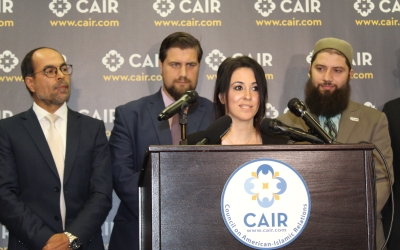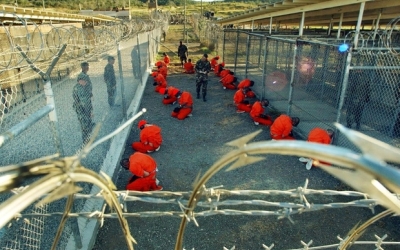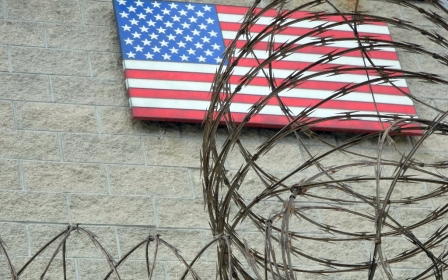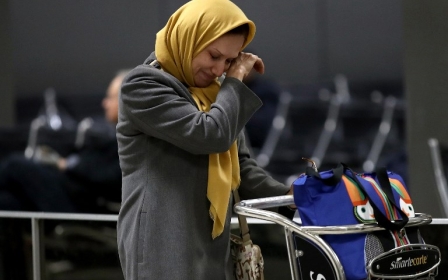US: New exhibition depicts 'war on terror' from Muslim eyes
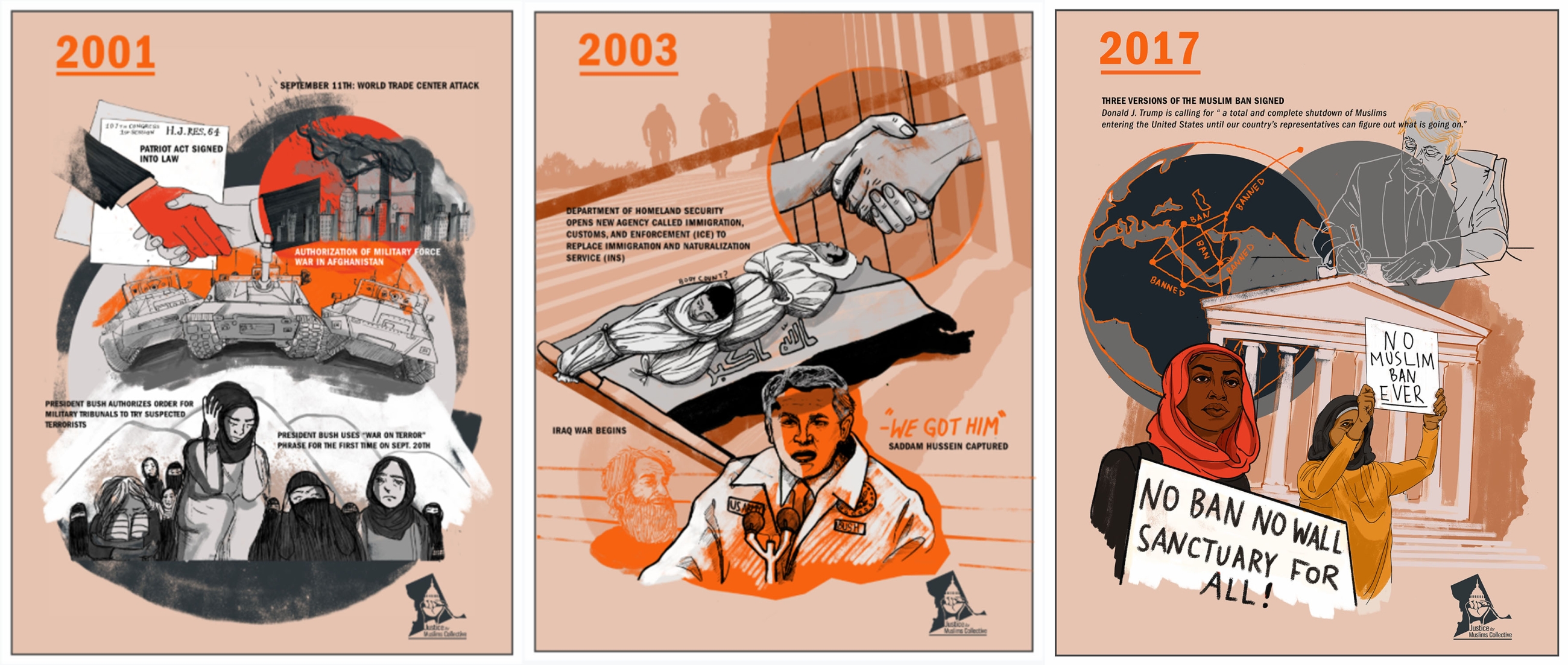
It has been 18 years since the 9/11 attacks, an event that drastically changed the geopolitics of the Middle East, catapulted the United States into forever wars and sparked the global fight against so-called "radical Islamic terrorism".
As US President Donald Trump and other American politicians marked the anniversary on Wednesday with somber messages, elsewhere in Washington, Muslim-American activists launched an art exhibit illustrating how the US-led "war on terror" has affected Muslim communities worldwide.
Organised by the Justice for Muslims Collective (JMC), a Washington-based coalition that challenges structural Islamophobia, the temporary exhibition featured a visual timeline depicting how US policies and programmes implemented since the 11 September attacks have harmed Muslims both in the US and abroad.
A work of art for each year between 2001 and 2019 was on display in a room at the True Reformer Building, a community space on U Street, a historic thoroughfare that is often referred to as the heart of African-American culture in the country.
"My goal was to create visuals - with the wonderful help of artists - that would demonstrate how deeply rooted Islamophobia has been throughout the 'war on terror'," Maha Hilal, the JMC director, said on Wednesday as the exhibition was opened to the public.
New MEE newsletter: Jerusalem Dispatch
Sign up to get the latest insights and analysis on Israel-Palestine, alongside Turkey Unpacked and other MEE newsletters
The timeline begins in 2001 with the attacks on the World Trade Center buildings in New York, and the subsequent Patriot Act, a piece of legislation signed into force by then-President George W Bush in the aftermath of the 9/11 attacks that was used to surveil US citizens, specifically targeting Muslims.
It then moves on to various key moments in the US's so-called "War on Terror", including the US invasion of Afghanistan, the torture of Iraqi prisoners in Abu Ghraib prison in Iraq at the hands of American soldiers, and the opening of the Guantanamo Bay detention centre.
The exhibition also delves into Washington's use of deadly drone strikes in Pakistan, Somalia and Yemen, various cases of entrapment of Muslim Americans and the creation of the Countering Violent Extremism (CVE) programme during former US President Barack Obama's administration.
CVE was introduced as a means of curbing efforts by extremists to recruit and radicalise individuals. Alongside law enforcement agencies, NGOs, and mental health providers, the programme involves monitoring communities for risks of radicalisation.
However, it has been widely criticised for not providing concrete ways to prevent the spread of extremism, for overwhelmingly targeting Muslim communities and for treating Muslims as inherently suspicious.
"As someone who loves, or loved, Obama, it's really difficult to see him culpable in so much of what's led us to the current day CVE," said Sarah Khan, a Muslim-Canadian curriculum developer in Washington, who attended the opening night event.
"[The programme] was opened under his administration, and so many of the drone attacks were released by his executive orders as well," Khan told MEE.
Bringing 'light' to people who suffered
The images from the timeline were drawn by 18-year-old Zaynub Siddiqui, a student at the University of Maryland, and then digitised by graphic designer Maura Dwyer of The Sanctuaries DC, an interfaith community arts space that oversaw the construction of the timeline.
Walking into the exhibition, visitors are met with a row of posters on easels, set up in front of each wall.
'One of the reasons we created our timeline was to root a public memory of the 'War on Terror' from Muslim eyes in American consciousness'
- Maha Hilal, director of Justice for Muslims Collective
Each poster is a mashup of drawings that depict what happened in a specific year in the timeline so with each step you move closer to the present day.
Siddiqui said it took her longer than she expected to draw the pieces because each time Hilal sent her a description of the issue she wanted her to capture, she was horrified by its brutality.
"It would take me at least 15 to 20 minutes to look at the [descriptions] and then have to draw them," she said, before breaking into tears as she looked around the room at the artwork she created.
"I hope this project is used to educate people and I hope it helps our ummah [community] and it brings light to the people who suffered so immensely," Siddiqui told MEE.
Public memory
While the exhibition in Washington was temporary - the images were only on display for the 9/11 anniversary on Wednesday - Hilal said she hopes it can be shown countrywide to shed light on how the US government has normalised ill-treatment of Muslims, while also demonstrating how Washington's scapegoating of Muslims has been integrated into the country's national security infrastructure.
"One of the reasons we created our timeline was to root a public memory of the 'War on Terror' from Muslim eyes in American consciousness," she told MEE.
Hilal said there are myriad examples of how the state has used violence against Muslims during the "war on terror".
She pointed to the abuse of predominantly Muslim detainees at Guantanamo Bay, where many were subjected to force-feeding, waterboarding, sleep deprivation and stress positions.
In 2017, an independent UN human rights investigator also said torture was still taking place at Guantanamo despite the US banning "enhanced interrogation techniques" more than a decade ago.
James Yee, a former US army captain who was the Muslim chaplain at Guantanamo, wrote in his memoir that "Islam was systematically used as a weapon against the prisoners", the New Yorker reported in April.
In that context, Hilal said the artwork aimed to disrupt "the state's narrative on what does or doesn't constitute violence, who gets to live, and who has to die, and what it means to create an entire apparatus to criminalise, dehumanise, and harm Muslims".
Khan, the curriculum developer, added that the exhibit made clear just how destructive the "War on Terror" has been for Muslims.
"It's sad because there's so much blatant evidence that those who have been impacted by the war on terrorism far outweigh the number of people who have been attacked on 9/11," she said. "And yet the narrative and the shame and the blaming is still falling on the latter group."
Middle East Eye delivers independent and unrivalled coverage and analysis of the Middle East, North Africa and beyond. To learn more about republishing this content and the associated fees, please fill out this form. More about MEE can be found here.


